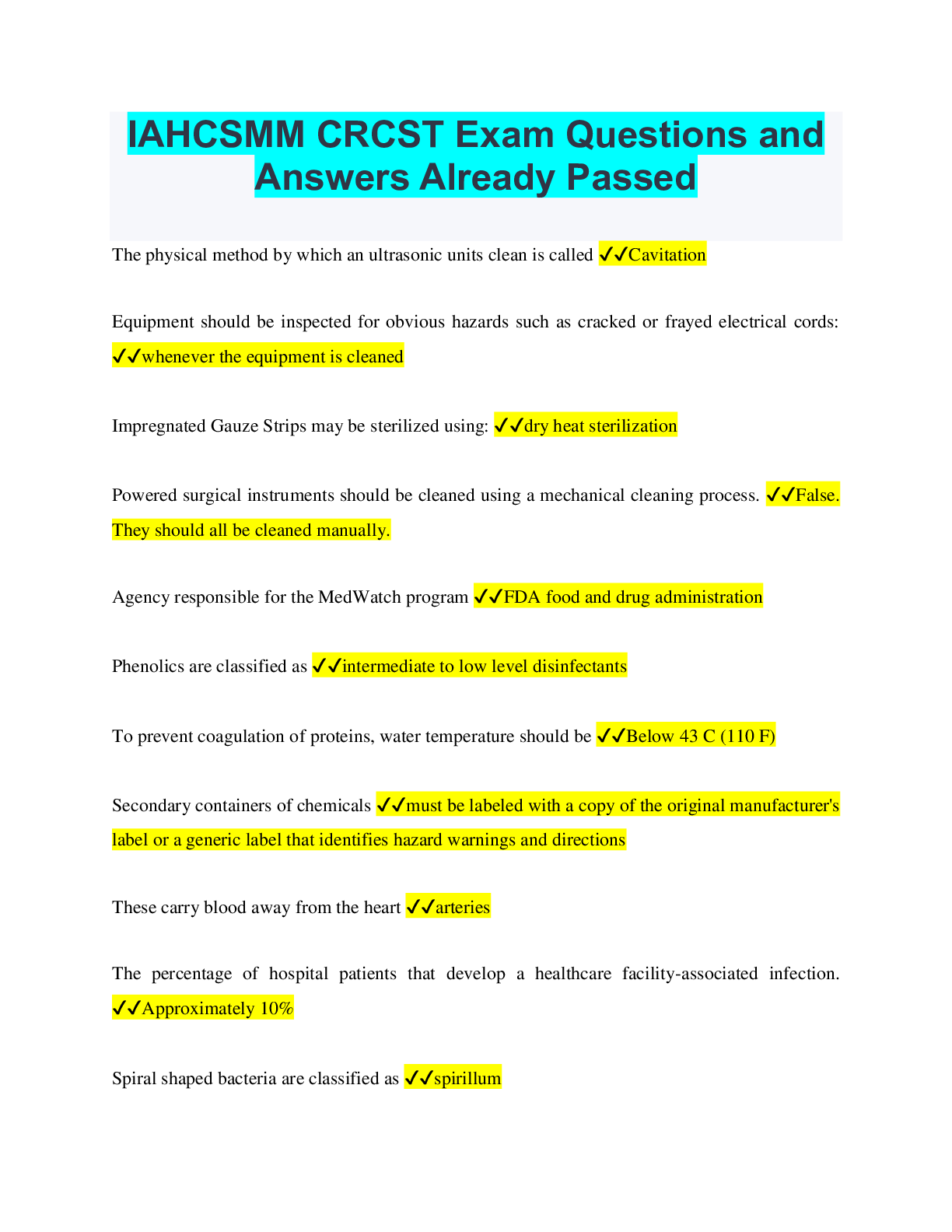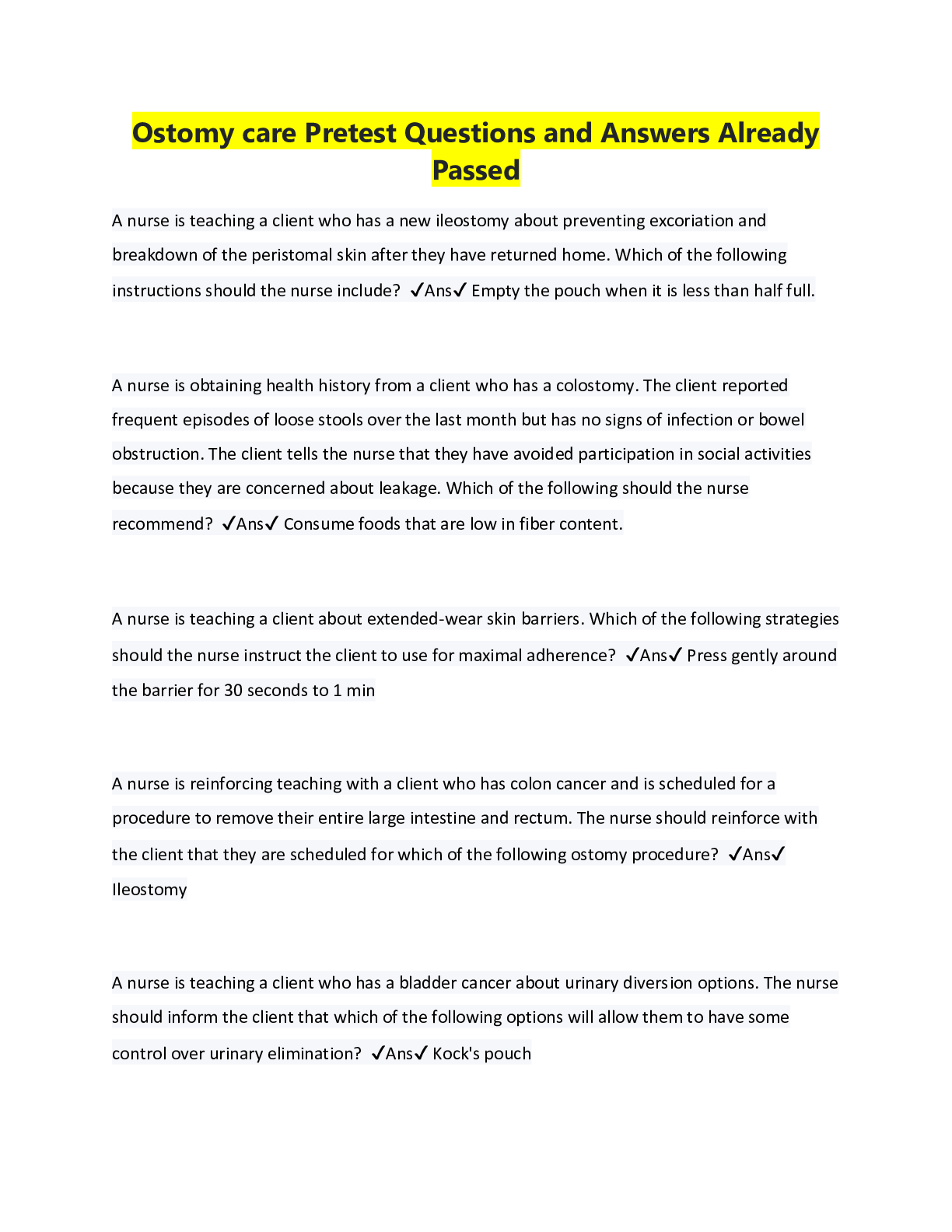*NURSING > QUESTIONS & ANSWERS > Maternal Newborn Proctored Exam questions and Answers already Graded A (All)
Maternal Newborn Proctored Exam questions and Answers already Graded A
Document Content and Description Below
1. Two days after delivery, a postpartum client prepares for discharge. What should the nurse teach her about lochia flow? Incorrect: Lochia does change color but goes from lochia rubra (bright red) ... on days 1-3, to lochia serosa (pinkish brown) on days 4-9, to lochia alba (creamy white) days 10-21. Incorrect: Numerous clots are abnormal and should be reported to the physician. Incorrect: Saturation of the perineal pad is considered abnormal and may indicate postpartum hemorrhage. Correct: Lochia normally lasts for about 21 days, and changes from a bright red, to pinkish brown, to creamy white. The color of the lochia changes from a bright red to white after four days Numerous large clots are normal for the next three to four days Saturation of the perineal pad with blood is expected when getting up from the bed Lochia should last for about 3 weeks, changing color every few days 2. A nurse monitors fetal well-being by means of an external monitor. At the peak of the contractions, the fetal heart rate has repeatedly dropped 30 beats/min below the baseline. Late decelerations are suspected and the nurse notifies the physician. Which is the rationale for this action? Incorrect: A nuchal cord (cord around the neck) is associated with variable decelerations, not late decelerations. Incorrect: Variable decelerations (not late decelerations) are associated with cord compression. Incorrect: Late decelerations are a result of hypoxia. They are not reflective of the strength of maternal contractions. Correct: Late decelerations are associated with uteroplacental insufficiency and are a sign of fetal hypoxia. Repeated late decelerations indicate fetal distress. The umbilical cord is wrapped tightly around the fetus' neck The fetal cord is being compressed due to rapid descent of the fetal head Maternal contractions are not adequate enough to deliver the fetus The fetus is not receiving adequate oxygen and is in distress 3. Which preoperative nursing interventions should be included for a client who is scheduled to have an emergency cesarean birth? Incorrect: Monitoring O2 saturations and administering pain medications are postoperative interventions. Incorrect: Taking vital signs every 15 minutes is a postoperative intervention. Instructing the client regarding breathing exercises is not appropriate in a crisis situation when the client's anxiety is high, because information would probably not be retained. In an emergency, there is time only for essential interventions. Correct: Because this is an emergency, surgery must be performed quickly. Anxiety of the client and the family will be high. Inserting an indwelling catheter helps to keep the bladder empty and free from injury when the incision is made. Incorrect: The nurse should have assessed breath sounds upon admission. Breath sounds are important if the client is to receive general anesthesia, but the anesthesiologist will be listening to breath sounds in surgery in that case. Monitor oxygen saturation and administer pain medication. Assess vital signs every 15 minutes and instruct the client about postoperative care. Alleviate anxiety and insert an indwelling catheter. Perform a sterile vaginal examination and assess breath sounds. 4. Which nursing instruction should be given to the breastfeeding mother regarding care of the breasts after discharge? Incorrect: Engorgement occurs on about the third or fourth postpartum day and is a result of the breast milk formation. The primary way to relieve engorgement is by pumping or longer nursing. Giving a bottle of formula will compound the problem because the baby will not be hungry and will not empty the breasts well. Incorrect: Applying lotion to the nipples is not effective for keeping them soft. Excessive amounts of lotion may harbor microorganisms. Correct: In order to stimulate adequate milk production, the breasts should be pumped if the infant is not sucking or eating well, or if the breasts are not fully emptied. Incorrect: Using soap on the breasts dries the nipples and can cause cracking. The baby should be given a bottle of formula if engorgement occurs. The nipples should be covered with lotion when the baby is not nursing. The breasts should be pumped if the baby is not sucking adequately. The breasts should be washed with soap and water once per day. 5. A client in preterm labor is admitted to the hospital. Which classification of drugs should the nurse anticipate administering? Correct: Tocolytics are used to stop labor. One of the most commonly used tocolytic drugs is ritodrine (Yutopar). Incorrect: Anticonvulsants are used for clients with pregnancy-induced hypertension who are likely to seize. Incorrect: The glucocorticoids (e.g., betamethasone and dexamethasone) are used for accelerating fetal lung maturation and production of surfactant. They are commonly used if the membranes are ruptured or labor cannot be stopped. Incorrect: Anti-infective are used if there is infection. Preterm labor may or may not involve ruptured membranes with its accompanying risk of infection. Tocolytics Anticonvulsants Glucocorticoids [Show More]
Last updated: 1 year ago
Preview 1 out of 9 pages

Reviews( 0 )
Document information
Connected school, study & course
About the document
Uploaded On
Aug 20, 2021
Number of pages
9
Written in
Additional information
This document has been written for:
Uploaded
Aug 20, 2021
Downloads
0
Views
50

.png)
.png)
.png)
.png)
.png)
.png)
.png)
.png)
.png)
.png)
.png)

.png)

.png)
.png)
.png)


.png)
.png)
.png)

.png)





.png)
.png)
.png)
.png)

